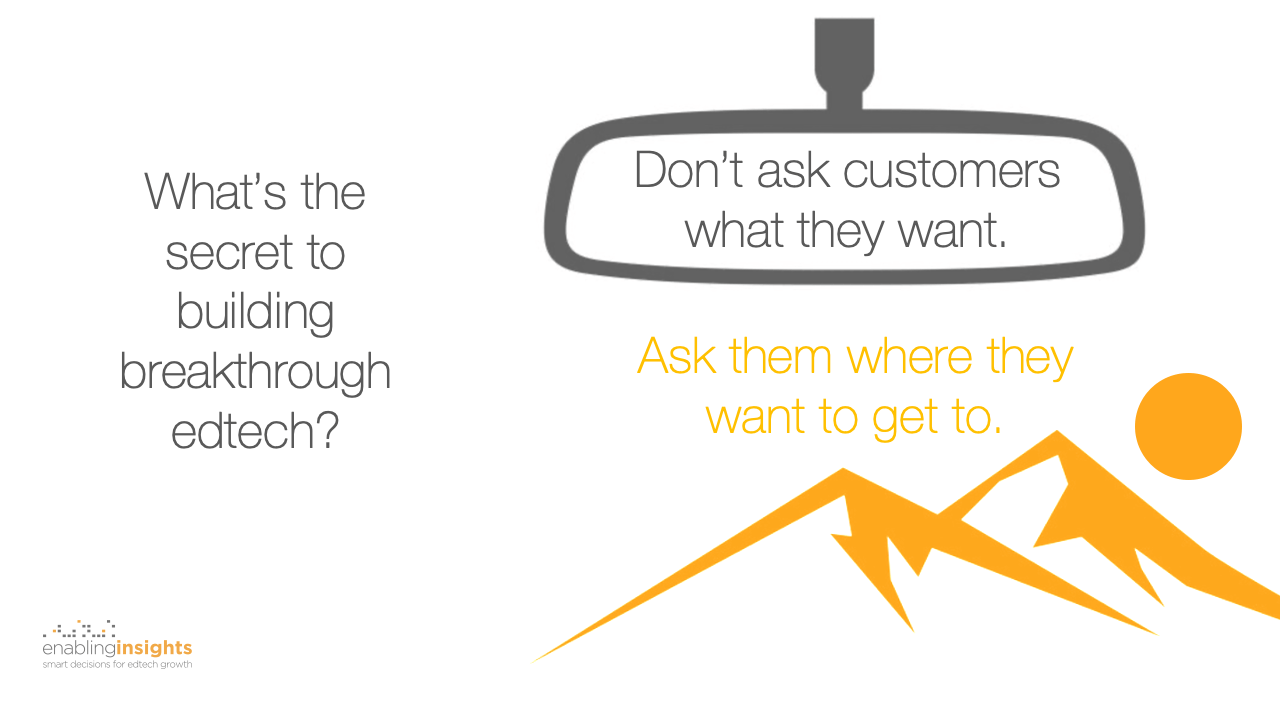Don’t ask customers what they want—ask them where they want to get to

A confession
I have a confession to make. I strongly advocate that you shouldn’t ask customers what they want if you hope to build breakthrough edtech.
Yes, customer obsession is a requirement for success
Just to get one thing straight, I’m obsessed with customers. Anybody who’s worked with me will know that I challenge every decision in terms of customer benefits and doggedly seek out customer insights. It’s a passion that’s shaped every facet of every successful edtech product I’ve built and every strategy I’ve devised.
And, of the many edtech companies I’ve assessed, coached, or tracked over nearly three decades, those that have won at scale share a common characteristic—they’re driven by a CEO who’s created a culture that is customer obsessed. [Look out for my upcoming interview with Paul Gollash of Voxy for a great example, and see my recommendations for Five activities that differentiate promising edtechs from those that become great.]
So, why would I advocate that you shouldn’t ask your target customers what they want?
Asking customers what they want gives you a rear-view of the past, not a vision for a better future
A mistake I often see edtech companies make is to build a vision based on asking customers what they want—in ideation sessions, focus groups, and market research. Yes, this line of enquiry will give you lots of useful insights into your competitors, chinks in their armor, and way to improve upon what they offer. But, those insights will be anchored in customers’ current experiences and the frustrations and limitations of those. Using that as your product blueprint is fundamentally a bad strategy. At best, it will get you to a slightly better version of what customers already have. And, that won’t be enough to win—you won’t displace incumbents with a me-too product offering incremental benefits, and you’ll find yourself drawn into a costly arms race of features that you’ll never win.
Know when to listen to your target customers, and when to ignore them
Many leaders who’ve changed industries have philosophized about how to envisage breakthrough products. Henry Ford is attributed with having said something like “If I’d asked customers what they wanted, they would’ve told me a faster horse.” And, Steve Jobs infamously believed that “You can’t just ask customers what they want and try to give them that. By the time you get it built, they’ll want something else.”
The point they were both getting at is the importance of looking beyond what customers say they need and knowing when to trust your intuition and ignore their requests. In my experience, a version of this approach is foundational to building breakthrough edtech. Though, let me just clarify—the issue I’m alluding to is not to do with customers’ needs changing so quickly that any edtech product may be outdated in a few years (because I don’t think that’s true in most education sectors—courseware in US higher-education, for example, is currently dominated by products that are 15+ years old).
Get back to basics if you want to identify breakthrough opportunities
Instead, I always like to get back to basics and ask customers (whether students, parents, teachers, instructors, or institutional leaders) about their ambitions—not what do you want (a product-centered question), but where do you want to get to (a customer- and outcome-centered line of enquiry)? The more you probe this question over and over, the richer the understanding you’ll build of what your customers really want to achieve (outcomes, in the broadest sense). And, with that, you can start to crystalize a North Star that will take your business, your staff, and your product to a new competitive plane.
Zig while your competitors zag
If you adopt this strategy, in my experience you’ll build a product that delivers material value towards goals that your customers’ really care about, they will tolerate gaps and deficiencies, and you will win. As a valued peer once coached me, “If your early adopters are so wedded to the breakthough benefits that your product delivers that they’re asking for refinements and additions, you know you’re onto a good thing!” (as opposed to dropping it because the benefits don’t outweigh the deficiencies).
The other benefit of this approach is that it allows you to start a fresh conversation with your target customers about matters they really care about. And, in an over-crowded market where many customers are jaded with the same pitch, it pays to zig while your competitors zag.
Dig deeper and be bold
So, dig deeper. Don’t ask your target edtech customers what they want—ask them about their ambitions, what they want to achieve, and where they want to get to. It’ll set you on a bold and distinctive path to success.
Need help? Have feedback?
If you want an independent, incisive, and experienced assessment of your strategy and competitive positioning, and practical advice for how to accelerate, please contact us using the form below—we’d love to help. We also welcome your feedback or questions on this blog—just use the form below and start “Your challenge” with the word “Feedback”.
